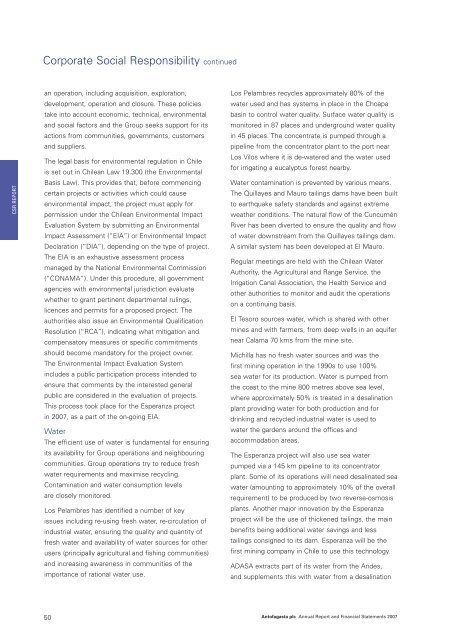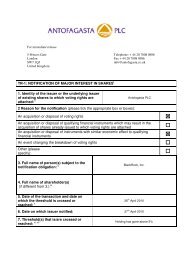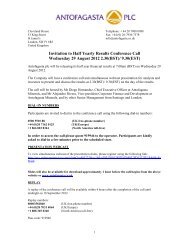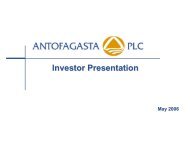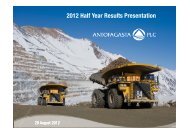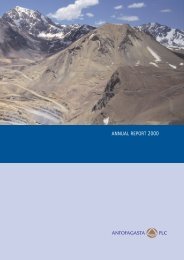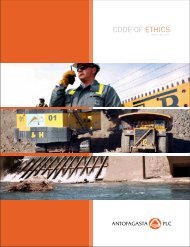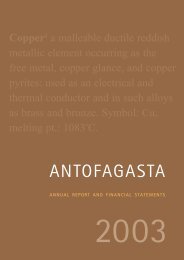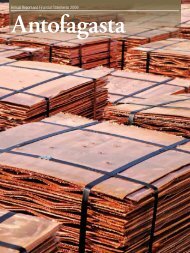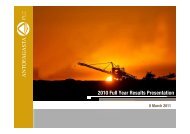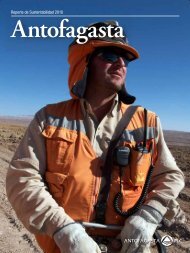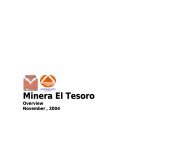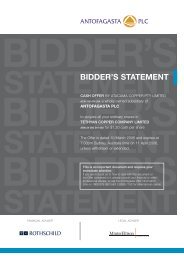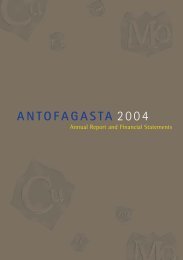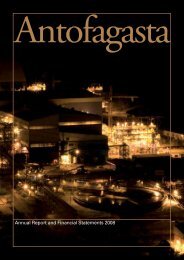Annual Report 2007 - Antofagasta plc
Annual Report 2007 - Antofagasta plc
Annual Report 2007 - Antofagasta plc
Create successful ePaper yourself
Turn your PDF publications into a flip-book with our unique Google optimized e-Paper software.
Corporate Social Responsibility continuedCSR REPORTan operation, including acquisition, exploration,development, operation and closure. These policiestake into account economic, technical, environmentaland social factors and the Group seeks support for itsactions from communities, governments, customersand suppliers.The legal basis for environmental regulation in Chileis set out in Chilean Law 19.300 (the EnvironmentalBasis Law). This provides that, before commencingcertain projects or activities which could causeenvironmental impact, the project must apply forpermission under the Chilean Environmental ImpactEvaluation System by submitting an EnvironmentalImpact Assessment (“EIA”) or Environmental ImpactDeclaration (“DIA”), depending on the type of project.The EIA is an exhaustive assessment processmanaged by the National Environmental Commission(“CONAMA”). Under this procedure, all governmentagencies with environmental jurisdiction evaluatewhether to grant pertinent departmental rulings,licences and permits for a proposed project. Theauthorities also issue an Environmental QualificationResolution (“RCA”), indicating what mitigation andcompensatory measures or specific commitmentsshould become mandatory for the project owner.The Environmental Impact Evaluation Systemincludes a public participation process intended toensure that comments by the interested generalpublic are considered in the evaluation of projects.This process took place for the Esperanza projectin <strong>2007</strong>, as a part of the on-going EIA.WaterThe efficient use of water is fundamental for ensuringits availability for Group operations and neighbouringcommunities. Group operations try to reduce freshwater requirements and maximise recycling.Contamination and water consumption levelsare closely monitored.Los Pelambres has identified a number of keyissues including re-using fresh water, re-circulation ofindustrial water, ensuring the quality and quantity offresh water and availability of water sources for otherusers (principally agricultural and fishing communities)and increasing awareness in communities of theimportance of rational water use.Los Pelambres recycles approximately 80% of thewater used and has systems in place in the Choapabasin to control water quality. Surface water quality ismonitored in 87 places and underground water qualityin 45 places. The concentrate is pumped through apipeline from the concentrator plant to the port nearLos Vilos where it is de-watered and the water usedfor irrigating a eucalyptus forest nearby.Water contamination is prevented by various means.The Quillayes and Mauro tailings dams have been builtto earthquake safety standards and against extremeweather conditions. The natural flow of the CuncuménRiver has been diverted to ensure the quality and flowof water downstream from the Quillayes tailings dam.A similar system has been developed at El Mauro.Regular meetings are held with the Chilean WaterAuthority, the Agricultural and Range Service, theIrrigation Canal Association, the Health Service andother authorities to monitor and audit the operationson a continuing basis.El Tesoro sources water, which is shared with othermines and with farmers, from deep wells in an aquifernear Calama 70 kms from the mine site.Michilla has no fresh water sources and was thefirst mining operation in the 1990s to use 100%sea water for its production. Water is pumped fromthe coast to the mine 800 metres above sea level,where approximately 50% is treated in a desalinationplant providing water for both production and fordrinking and recycled industrial water is used towater the gardens around the offices andaccommodation areas.The Esperanza project will also use sea waterpumped via a 145 km pipeline to its concentratorplant. Some of its operations will need desalinated seawater (amounting to approximately 10% of the overallrequirement) to be produced by two reverse-osmosisplants. Another major innovation by the Esperanzaproject will be the use of thickened tailings, the mainbenefits being additional water savings and lesstailings consigned to its dam. Esperanza will be thefirst mining company in Chile to use this technology.ADASA extracts part of its water from the Andes,and supplements this with water from a desalination50<strong>Antofagasta</strong> <strong>plc</strong> <strong>Annual</strong> <strong>Report</strong> and Financial Statements <strong>2007</strong>


